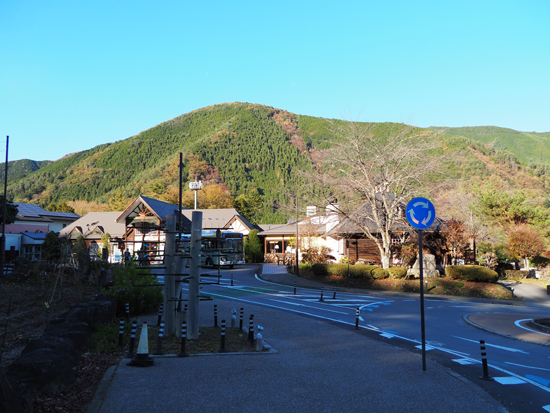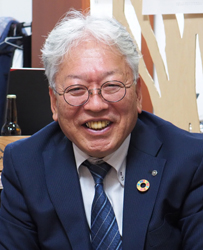Series ”Visiting the village” in search of the key to regional revitalization 9 Kosuge Village, Yamanashi


船木村長(Mayor Funaki )
Kosuge Village is a village located in eastern Yamanashi Prefecture with a population of just under 700 people, an aging rate of about 46%, and a birth rate of about 1. Forests occupy 95% of the total area, and the village is surrounded by mountains. At its peak in the 1950s, about 2,200 people lived there, but during the period of high economic growth, many of the villagers moved to metropolitan areas such as Tokyo.
The village’s main industries are commerce, industry and tourism, and many of the villagers are office workers. There are few workers in the primary industry. In agriculture, part-time farmers engage in wasabi, konjac, and sericulture. The fishing industry involves cultivating high-quality fish such as yamame trout, trout, and char, which are known as”queen of mountain streams”. Although the number of forestry workers is small overall, 40% of the forests in Kosuge Village are watershed forests for Tokyo, and villagers are involved in their maintenance and management.
When you hear this much, you might imagine that it is a marginal village, but Kosuge Village has been hailed as one of the most advanced and challenging villages in Japan.
I took the JR Chuo Line Ome Special Express from Shinjuku Station for about an hour, got off at Kawabe Station in Ome City, and from there headed to Kosuge Village in a rental car. After driving along a winding mountain road for about an hour, a small town suddenly opens up. That is Kosuge Village.
”My motto is ‘The village to be a challenger”. Even if it is a depopulated village, by taking on various challenges, the entire village will be redesigned and become a smart village that will become easier to live in”.
Village Mayor Naomi Funaki says:
In fact, villages are facing a variety of challenges, and there are too many specific examples to list.
One is ”NIPPONIA Kosuge Genryu no Mura” a new model of renovating old folk houses that treats the entire village as one hotel. A 150-year-old mansion was renovated into a hotel. Currently, inbound demand is strong, and approximately 60% of the seats are occupied by inbound tourists.
By the way, it seems that in recent years there has been an increase in the number of foreign couples holding weddings in Kosuge Village. The first couple were Australian. They rented out a hotel and held a Japanese-style wedding ceremony wearing kimonos. It has become a hot topic on social media, and an increasing number of foreigners are getting married in Kosuge Village.
The village is also active in the delivery business using drones, and various demonstration experiments are being conducted.
“We started drone logistics in 2020. There are currently only two shops in Kosuge Village. There are many areas in the village where it is difficult to do daily shopping without a private car. At such times, we decided to fly a drone. “We didn’t have a space, so we asked if something could be done, so we decided to make it possible to fly them in the village”, explains Mayor Funaki.
Currently,they are working with Seino Holdings and others to promote the social implementation of drones in preparation for the 2024 problem. They are conducting joint delivery as part of the new smart logistics SkyHub implementation. SkyHub is a platform developed by Aeronext and Seino Holdings that connects existing logistics and drone logistics.
“Using drone logistics, villagers can have the products they purchase delivered right to their doorsteps. Kosuge Village has a high aging rate, and some elderly people are handing in their driver’s licenses, so securing a means of transportation is essential. We place emphasis on enrichment” (Mayor Funaki).
Some villagers have requested the establishment of a convenience store. Therefore, in conjunction with drone logistics, we are considering setting up a stockyard, an unmanned convenience store.
“We would like to put together a plan within this fiscal year and move into full swing next fiscal year.If we had unmanned convenience stores, we would be able to move toward cashless payments and elderly people would become accustomed to digital technology”, Mayor Funaki said.
In addition, focusing on the related population, people who visit the village for sightseeing etc. (exchange population) are called”1/3 villagers,” and people involved in village development (related population) are called “1/2 villagers”. We operate a point card system called”Kosuge Villager Point Card” that positions people (settled population) as “1/1 villager” and provides incentives. Currently, there are about 3,000 half-village residents, mostly in their 50s and 60s.
The village also focuses on housing policy. He has built 10 tiny houses so far. We held a contest called the ”Kosuge Village Tiny House Project,” inviting designs rich in ideas and humor. The design that won the highest award is actually being constructed.
Mayor Funaki said, ”We believe that when designing a village, we start with the buildings, so while the buildings are innovative, they still have a sense of unity.Currently, the construction of major facilities such as the village office and roadside station is done by Kosuge Village. Kosuge Tsukuruza, which employs first-class architects who live in Japan, handles many of the projects”.
Mr. Takao Wada, who leads Kosuge Tsukuru-za, used to work for a company in Kofu City, but after retiring, he joined the community revitalization cooperation team in Kosuge Village and settled there. He founded Kosuge Tsukuru-za.
What motivates Kosugemura to take on this challenge?
Mayor Funaki said, ”Kosuge Village has a high aging rate, and if nothing is done, the population will be around 290 in 2060.Population is not the only barometer, but in the sense that it is suffering from a declining birthrate and aging population, as well as a declining population. It’s a microcosm of Japan. Conversely, if we can revitalize villages and make them smart, livable areas, we can also revitalize Japan and make it a smart, livable country. That’s what we are working on”.
The challenges will continue.
“What we would like to focus on in particular is the effective use of optical infrastructure.The village is 100% covered by optical infrastructure, and each home has light.However, currently it is only used for retransmitting television. I want to make more effective use of this interactivity. Depending on your ideas, you can do a lot of things, so I want to explore new ways to use it,” said Mayor Funaki.
Local production and consumption of energy will also be considered. As part of this effort, a wood boiler was introduced. Up until now, the village’s forest had been thinned but left unattended, but they will purchase the cut wood for 5,000 yen per cubic meter and use it as firewood. For example, we have made it possible to take a bath even if there is no electricity at evacuation centers during disasters.
Mayor Funaki says, “I would like Kosuge Village to be used more and more as DX testing ground.Kosuge Village is a microcosm of Japan, and the solutions realized here can be spread across the country”.
